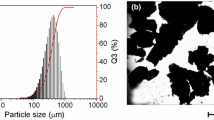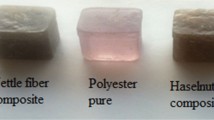Abstract
An analysis is made of the feasibility of using wastes from the production of linen yarm (scutch, spinning and carding refuse) to modify low-density polyethylene. The effect of the composition and concentration of wastes on the processing properties (melt index), physicomechanical indices (tensile strength, elastic modulus in bending), and water resistance of composites based on low-density polyethylene is studied. It is found that the melt index decreases with an increase in the content of filler and that even a composite with a high filler content (40–50% by weight) maintains values of 0.2–0.3 g/10 min. The elastic modulus in bending increases with an increase in the content of waste, regardless of the nature of the latter. Tensile strength increases slightly and depends on the choice of filler. This result, combined with the reducation in the scatter of values of elastic modulus with an increase in filler concentration, is an indicator of the relatively high degree of heterogeneity of the systems that were studied. The water resistance of the composites decreases with an increase in filleer content. To reduce the heterogeneity of the systems, mixing should be intensified and modifiers such as stearic acid and polyisocyanates should be added.
Similar content being viewed by others
References
A. C.-R. Carlos, “Mechanical properties of reinforced thermoplastics,” Natural Fiber Reinforced Thermoplastics. Elsevier, London (1986), Chap. 3, pp. 110–162.
A. J. Mitchell and D. Willis, “Cellulosic fibres for reinforcement,” Appita,31, No. 5, 347–354 (1984).
P. K. Ray, A. S. Chakvarvarty, and B. Bandyodpadhvay, “Fine structure and mechanical properties of jute differently dried after retting,” J. Appl. Polym. Sci.,20, 1765–1767 (1976).
R. A. Padilla and S. A. Sanchez, “Development of new composite material from waste polymers, natural fibrie and mineral fillers,” ibid.,29, 2405–2412 (1984).
M. S. Kukharev, “Study of hemp and jute fibers in linin production,” Tekst. Prom., No. 8-9, 23–25 (1993).
M. M. Sain, C. Imbert, and B. V. Kokta, “Composites of surface treated wood fiber and recycled p polypropylene,” Angew. Makromol. Chem.,210, No. 3586, 33–46 (1993).
C. Clarou, I. Kubat, and E. Stromvall, “The efficiency of cellulosic fibers in common thermoplastics Pt. 1. Filling without processing aids or coupling agents,” Int. J. Polym. Sci.,10, 159–187 (1984).
A. A. Vigdorovich and A. I. Vigdorovich, “Some problems of the rheology and ecology of wood-filled polyolefins,” Plast. Massy, No. 2, 29–30 (1991).
V. M. Shapovalov, V. G. Barsukov, U. I. Lapshina, and V. I. Gubkin, “Composite finishing materials composed of wood fibers and thermoplastics,” Stroit. Mater., No. 5, 18–20 (1991).
P. Gatenholm, “The effect of surface-induced interactions on the properties of fiber-waste plastic composites. Woodfiber-plastic composites: Virgin and recycled wood fiber and polymers for composites,” May 1–3, 1995. Madison, Wisconsin.
A. I. Tryapkin, Secondary Raw Materials and Their Treatment [in Russian], Legkaya Industria, Moscow (1967).
Setsuo Takase and Nobuo Shiraishi, “Studies and composites from wood and polyethylene,” J. Appl. Polym. Sci.,37, 645–659 (1989).
R. G. Raj, B. V. Kokta, and C. Daneault, “Wood fiber as a low cost reinforcing filler for polyethylene: Studies on mechanical properties,” J. Mater. Sci.,25, 1851–1855 (1990).
K. L. Jam, B. K. Gogol, C. C. Lai, and S. E. Selke, “Composites from compounding wood fibres with recycled high density polyethylene,” Polym. Eng. Sci.,30, No. 11, 693–699 (1990).
G. Jaymol, S. S. Bhagawan, N. Prabhakaran, and T. S. Sabu, “Short pineapple-leaf fiber-reinforced low density polyethylene composites,” J. Appl. Polym. Sci.,57, 843–854 (1995).
A. C. Karmaker and G. Hinrichsen, “Processing and characterization of jute fiber reinforced thermoplastic polymers,” Polym. Plast. Technol. Engl.,30, 609–629 (1991).
R. G. Raj, and B. V. Kokta, “Reinforcing high density polyethylene with cellulosic fibres: Effect of additives on fibre dispersion and mechanical properties,” Polym. Eng. Sci.,31, No. 18, 1358–1362 (1991).
R. G. Raj, B. V. Kokta, D. Maldas, and C. Daneault, “Usee of wood fibres in thermoplastics. VII. The effect of coupling agents in polyethylene—wood fibres composites,” J. Appl. Polym. Sci.,37, 1089–1103 (1989).
R. G. Raj and B. V. Kokta, “Compounding of cellulosic fibre with polypropylene: Effect of fibre treatment on dispersion in the polymer matrix,” ibid.,38, 1987–1996 (1989).
J. Manson and L. Sperling, Polymer Mixtures and Composities [Russian translation], Khimiya, Moscow (1979).
Author information
Authors and Affiliations
Additional information
Translated from Mekhanika Kompozitnykh Materialov, Vol. 33, No. 3, pp. 408–416, May–June, 1997.
Rights and permissions
About this article
Cite this article
Kayaks, Y.A., Bulmanis, B.N., Reikhmane, S.A. et al. Effect of the composition and concentration of fibrous wastes from linen yarn production on the physicomechanical properties of polyolefin composites. Mech Compos Mater 33, 293–298 (1997). https://doi.org/10.1007/BF02256088
Received:
Issue Date:
DOI: https://doi.org/10.1007/BF02256088




